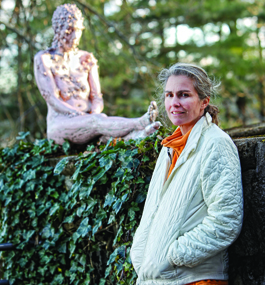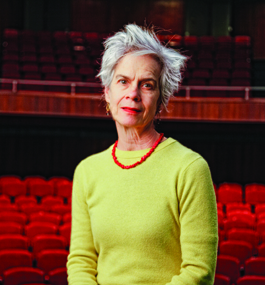A Collaboration Blossoms at Spingold
On the Brandeis stage, shape and movement perform a creative pas de deux.

Photo by Mike Lovett
Tory Fair
by Debra Cash ’78
When Assistant Professor of Sculpture Tory Fair was growing up in New Jersey, her mother, an avid and gifted self-taught gardener, spent a lot of time outdoors. The flowerbeds she planted in the yard dictated where Fair and her brothers were allowed to play.
Retrieving this summer memory, Fair has made flowers a symbol of the imagination in her work — images of potentiality, of blossoming. For instance, Fair, who joined the Brandeis faculty in 1997, used flowers prominently in a set of sculptures she created last year for “Testing a World View (Again),” an installation at the deCordova Sculpture Park and Museum in Lincoln, Mass.
In a surreal, feminist riff on a 1993 deCordova installation by British sculptor Antony Gormley, she cast her own naked body in plaster. She then created four seated figures in pink resin to install on the museum’s terrace, one of them sitting against a brick wall in an impossible position, perpendicular to the ground. Each of Fair’s four female figures had a head “swarming” in flowers, suggesting the presence of intangible, free-floating ideas, the curators wrote.
This spring, Fair’s flowers will be enlivened by bodies again — this time, the bodies of Brandeis dancers. Under the direction of choreographer Susan Dibble, the chair of theater arts, a group of undergraduates, graduate students and Brandeis alums — plus the 4-year-old daughter of one of Dibble’s Brandeis colleagues — will embark on a project called “Beyond the Boundaries.” Fair and Dibble expect that their collaboration, to be presented April 28–29 at the Spingold Theater Center Mainstage, will cast unexpected light on the connections between sculpture and dance.
The irony isn’t lost on Fair.
“I’ve taken my body out of the work,” she says with a smile, “and Susan is putting other bodies back in.”

Photo by Mike Lovett
Susan Dibble
page 2 of 2
Dibble was excited to challenge her typical working process by allowing the shape, weight and texture of Fair’s sculptures to drive her choreographic choices, which range from familiar movements from the world of child’s play — such as skipping and running — to the formality of dance steps from tango and waltzes.
In “Beyond the Boundaries,” audiences will see a series of 13 dreamlike episodes that combine Fair’s and Dibble’s work: Flowers set in lanes constrain the dancers’ paths; an “altar” is overtaken by flowers growing from beneath the table’s surface; special lighting effects turn the dancers’ silhouettes into unexpectedly verdant objects.
“Most of my work has been driven by theatrical concerns,” says Dibble, who has taught at Brandeis since 1987. “I teach movement for actors, and my last big project was a narrative based on Edith Wharton’s ‘The House of Mirth.’”
This is not the first time these women have blended their creative energies. Several years ago, Dibble and Fair gave a joint assignment to students in a graduate-level acting seminar and an intermediate-level sculpture class. Each actor was paired with a visual arts student. Then the partners were “let loose” to explore different aspects of the Spingold building, with its unusual curving walls, hidden staircases, large and small spaces and unexpected openings to the outdoors. In the course of the exercise, the students discovered that space and movement are naturally interdependent: Space invites and limits certain kinds of movement, while the perception of an empty space changes when bodies move through it.
With that fertile territory in mind, Dibble crafted a successful proposal to the Brandeis Arts Council. She explained that she and Fair, coming from distinct creative disciplines, hoped to join forces again on a project through which “students of sculpture will have the opportunity to see that sculpture has a life and that their work has an effect on the human body.”
What’s more, Dibble wrote, “dancers will be placed in a situation in which the body must share space with an object. All will challenge the boundaries of relationships with form and designed obstacles in space.”
Meeting in a Waltham café a few weeks before the project’s January auditions, Dibble and Fair were already hard at work defining the imagery that would animate the Spingold stage later in the spring. Fair decided to cast Gerbera daisies, tulips and daffodils at a range of scales — from delicate to bulky — out of expandable foam. Dibble, for her part, was eager to explore the sheer physicality of these objects, to sense how they feel moving in a dancer’s hands.
“This is a laboratory, and we’re sharing an experiment,” Dibble explains. “Borders are meant to be crossed.”
Debra Cash ’78, a longtime Boston arts critic, lecturer and design research manager, has been scholar-in-residence at Jacob’s Pillow and the Bates Dance Festival.
